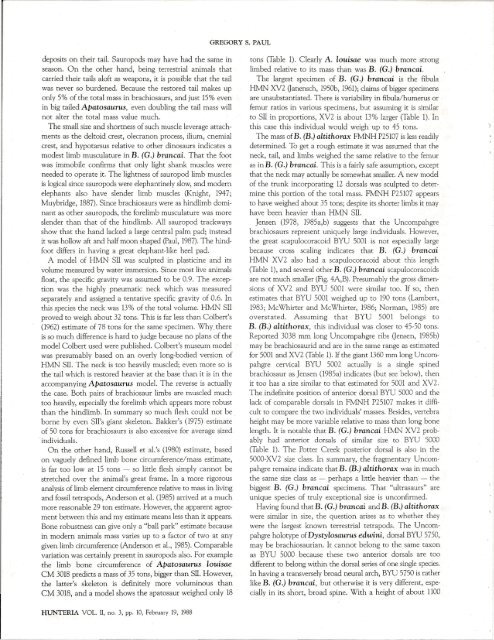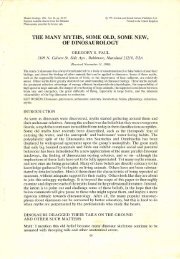HUNTERIA - Gregory S. Paul
HUNTERIA - Gregory S. Paul
HUNTERIA - Gregory S. Paul
Create successful ePaper yourself
Turn your PDF publications into a flip-book with our unique Google optimized e-Paper software.
...----------------<br />
deposits on their tail. Sauropods may have had the same in<br />
season. On the other hand, being terrestrial animals that<br />
carried their tails aloft as weapons, it is possible that the tail<br />
was never so burdened. Because the restored tail makes up<br />
only 5% of the total mass in brachiosaurs, and just 15% even<br />
in big tailed Apatosaurus, even doubling the tail mass will<br />
not alter the total mass value much.<br />
The small size and shortness of such muscle leverage attachments<br />
as the deltoid crest, olecranon process, ilium, cnemial<br />
crest, and hypotarsus relative to other dinosaurs indicates a<br />
modest limb musculature in B. (G.) brancai. That the foot<br />
was immobile confirms that only light shank muscles were<br />
needed to operate it. The lightness of sauropod limb muscles<br />
is logical since sauropods were e1ephantinely slow, and modern<br />
elephants also have slender limb muscles (Knight, 1947;<br />
Muybridge, 1887).Since brachiosaurs were as hindlimb dominant<br />
as other sauropods, the forelimb musculature was more<br />
slender than that of the hindlimb. All sauropod trackways<br />
show that the hand lacked a large central palm pad; instead<br />
it was hollow aft and half moon shaped (<strong>Paul</strong>, 1987).The hindfoot<br />
differs in having a great elephant-like heel pad.<br />
A model of HMN Sil was sculpted in plasticine and its<br />
volume measured by water immersion. Since most live animals<br />
float, the specific gravity was assumed to be 0.9. The exception<br />
was the highly pneumatic neck which was measured<br />
separately and assigned a tentative specific gravity of 0.6. In<br />
this species the neck was 13% of the total volume. HMN Sil<br />
proved to weigh about 32 tons. This is far less than Colbert's<br />
(1962) estimate of 78 tons for the same specimen. Why. there<br />
is so much difference is hard to judge because no plans of the<br />
model Colbert used were published. Colbert's museum model<br />
was presumably based on an overly long-bodied version of<br />
HMN Sil. The neck is too heavily muscled; even more so is<br />
the tail which is restored heavier at the base than it is in the<br />
accompanying Apatosaurus model. The reverse is actually<br />
the case. Both pairs of brachiosaur limbs are muscled much<br />
too heavily, especially the forelimb which appears more robust<br />
than the hindlimb. In summary so much flesh could not be .<br />
borne by even SIl's giant skeleton. Bakker's (1975) estimate<br />
of 50 tons for brachiosaurs is also excessive for average sized<br />
individuals.<br />
On the other hand, Russell et al.'s (1980) estimate, based<br />
on vaguely defined limb bone circumference/mass estimate,<br />
is far too low at 15 tons - so little flesh simply cannot be<br />
stretched over the animal's great frame. In a more rigorous<br />
analysis of limb element circumference relative to mass in living<br />
and fossil tetrapods, Anderson et al. (1985) arrived at a much<br />
more reasonable 29 ton estimate. However, the apparent agreement<br />
between this and my estimate means less than it appears.<br />
Bone robustness can give only a "ball park" estimate because<br />
in modern animals mass varies up to a factor of two at any<br />
given limb circumference (Anderson et al., 1985).Comparable<br />
variation was certainly present in sauropods also. For example<br />
the limb bone circumference of Apatosaurus louisae<br />
CM 3018 predicts a mass of 35 tons, bigger than Sil. However,<br />
the latter's skeleton is definitely more voluminous than<br />
CM 3018, and a model shows the apatosaur weighed only 18<br />
<strong>HUNTERIA</strong> VOL. II, no. 3, pp. 10, February 19, 1988<br />
GREGORY S. PAUL<br />
tons (Table 1). Clearly A. louisae was much more strong<br />
limbed relative to its mass than was B. (G.) brancai.<br />
The largest specimen of B. (G.) brancai is the fibula<br />
HMN XV2 (lanensch, 1950b, 1961);claims of bigger specimens<br />
are unsubstantiated. There is variability in fibula/humerus or<br />
femur ratios in various specimens, but assuming it is similar<br />
to Sil in proportions, XV2 is about 13% larger (Table 1). In<br />
this case this individual would weigh up to 45 tons.<br />
The mass ofB. (B.) altithorax FMNH P25107is lessreadily<br />
determined. To get a rough estimate it was assumed that the<br />
neck, tail, and limbs weighed the same relative to the femur<br />
as inB. (G.) brancai. This is a fairly safe assumption, except<br />
that the neck may actually be somewhat smaller. A new model<br />
of the trunk incorporating 12 dorsals was sculpted to determine<br />
this portion of the total mass. FMNH P25107 appears<br />
to have weighed about 35 tons; despite its shorter limbs it may<br />
have been heavier than HMN SIl.<br />
Jensen (1978, 1985a,b) suggests that the Uncompahgre<br />
brachicsaurs represent uniquely large individuals. However,<br />
the great scapulocoracoid BYU 5001 is not especially large<br />
because cross scaling indicates that B. (G.) brancai<br />
HMN XV2 also had a scapulocoracoid about this length<br />
(Table 1), and several other B. (G.) brancai scapulocoracoids<br />
are not much smaller (Fig. 4A,B). Presumably the gross dimensions<br />
of XV2 and 8YU 5001 were similar too. If so, then<br />
estimates that BYU 5001 weighed up to 190 tons (Lambert,<br />
1983; McWhirter and McWhirter, 1986; Norman, 1985) are<br />
overstated. Assuming that BYU 5001 belongs to<br />
B. (B.) altithorax, this individual was closer to 45-50 tons.<br />
Reported 3038 mm long Uncompahgre ribs (jensen, 1985b)<br />
may be brachiosaurid and are in the same range as estimated<br />
for 5001 and XV2 (Table 1).If the giant 1360mm long Uncompahgre<br />
cervical BYU 5002 actually is a single spined<br />
brachiosaur as Jensen (1985a) indicates (but see below), then<br />
it too has a size similar to that estimated for 5001 and XV2.<br />
The indefinite position of anterior dorsal BYU 5000 and the<br />
lack of comparable dorsals in FMNH P25107 makes it difficult<br />
to compare the two individuals' masses. Besides, vertebra<br />
height may be more variable relative to mass than long bone<br />
length. It is notable that B. (G.) brancai HMN XV2 probably<br />
had anterior dorsals of similar size to BYU 5000<br />
(Table 1). The Potter Creek posterior dorsal is also in the<br />
5000-XV2 size class. In summary, the fragmentary Uncompahgre<br />
remains indicate that B. (B.) altithorax was in much<br />
the same size class as - perhaps a little heavier than - the<br />
biggest B. (G.) brancai specimens. That "ultrasaurs" are<br />
unique species of truly exceptional size is unconfirmed.<br />
Having found that B. (G.) brancai and B. (B.) altithorax<br />
were similar in size, the question arises as to whether they<br />
were the largest known terrestrial tetrapods. The Uncompahgre<br />
holotype ofDystylosaurus edwini, dorsal 8YU 5750,<br />
may be brachiosaurian. It cannot belong to the same taxon<br />
as BYU 5000 because these two anterior dorsals are too<br />
different to belong within the dorsal series of one single species.<br />
In having a transversely broad neural arch, BYU 5750 is rather<br />
like B. (G.) brancai, but otherwise it is very different, especially<br />
in its short, broad spine. With a height of about 1100









